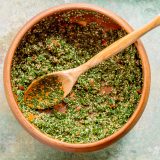The plan was Beirut. Because if Milk Street was going to make great tabbouleh—something bearing no resemblance to the insipid mush sold at grocery stores here—I wanted to go to the source.
And Lebanon, like many Arab countries across the Middle East, is tabbouleh country.
But given the unpredictability of the situation there, a visit didn’t seem wise. And just 132 miles away was Tel Aviv, one of the region’s culinary capitals. Surely Israeli tabbouleh was just as good?
Never found out. Despite spending four and a half days eating my way across Israel and Palestine—including a 25-course Arab meal featuring rich grains and vibrant bitter greens, often stuffed into cabbage or grape leaves, sometimes mounded into slaws and salads—I never encountered tabbouleh.
At least not as such. I ate some of its components. There was an Israeli salad of chopped cucumbers, tomatoes and fresh herbs sometimes dressed heavily, sometimes barely, with tahini and lemon. And sumac, the sweet-savory-lemony spice often used to give tabbouleh kick, showed up in numerous dishes.
But never a simple tabbouleh, that uncomplicated, vibrant mix of parsley, bulgur wheat, onion, tomato, lemon juice and olive oil. When done well, it is a bowl of fresh—heaps of bold herbs, sweet-acidic tomatoes that are moist but not wet, the bite of onion, a balance of oil and citrus.
Having failed in the Middle East (next trip!), we turned (somewhat) closer to home.
In the U.S., we think tabbouleh is a bulgur dish. Actually, the wheat should be almost an afterthought. As Israeli chef Yotam Ottolenghi tells it, tabbouleh is all about the parsley. His recipe calls for four bunches of parsley, plus two bunches of mint, all shredded by hand.
To all that, he adds just a third of a cup of fine bulgur wheat, softened with the liquid of two diced tomatoes. That’s a big difference from what we usually see—recipes calling for a cup or more of bulgur to one bunch fresh herbs.
For our tabbouleh, we wanted a dish that was full of flavor, so we took Ottolenghi’s lead. Our version is nearly all herbs, with a minimal amount of bulgur serving mostly to soak up juices. We also adopted his use of fresh mint (a common Lebanese tabbouleh ingredient) and combined allspice and sumac for a bright touch.
We used a shallot rather than an onion, preferring its gentler bite. We soaked it first in lemon juice to soften its flavor and texture.
We used fine-grain bulgur, which hydrates more easily. (Bulgur is made by boiling durum wheat berries until they are about to crack open, then allowing them to dry.) If you can’t find fine-grain, coarse bulgur can be ground in a spice grinder. Grind in short pulses until fine, light and fluffy, five to 10 pulses.
We also went easy on the water—slightly underhydrating the bulgur so it could absorb the tomato juices without becoming waterlogged. We considered toasting the bulgur but found it muddied the flavors.
One final lesson we learned: For this salad, dry herbs are best. Other than the initial half-cup of water to partially hydrate the bulgur, the only other liquid should be the tomatoes and dressing. So be sure to dry your parsley and mint very thoroughly.




